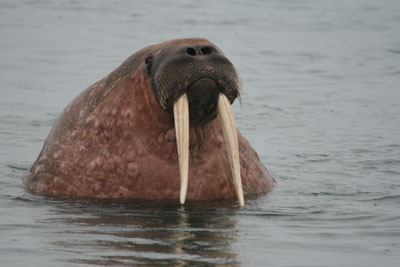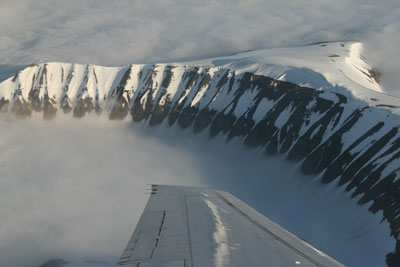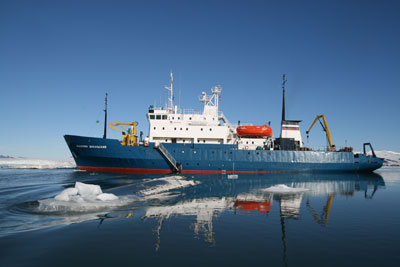An Arctic ice adventure
by Bill & Betty Reed, Denton, TX
They walked with purpose — gate 20, 21, 22… 35, 36 — looking like ants with determination on their faces. Every now and then I would join the procession, probably with the same look of determination.
By now it was around 11 o’clock and the flight we were supposed to take out of Oslo, Norway, had been delayed several times. Technical problems, we were told. With each delay came one more determined walk up and down the hall.
“Now boarding flight LH2422 to Tromsø and Longyearbyen at gate 40.”
It shot through our heads like wildfire. We were going to board the plane!
Around midnight we took off, headed north. The sky was dimly lit; the farther north we traveled, the lighter it got. After about an hour of flight we were in bright sunlight.
Out the window I could see the occasional snowcapped mountain peak above the clouds, the dark rock showing through. The entire world had been turned into one giant black-and-white photograph.
We were supposed to get off the plane in Tromsø, Norway, go through Customs and get right back on. Maybe the rules don’t apply after midnight, but we skipped that step going north. (We were not so lucky on our return at the end of the trip.) We landed, took on about five passengers and took off again. Another hour and we came to Longyearbyen, the starting place for our 11-day “Spitzbergen Explorer” cruise with Quark Expeditions.
Longyearbyen
Longyearbyen started out many years ago as a coal-mining town, essentially a company town. When it went bust, the Norwegian government took it over, determined to turn it into a viable community. It appears they have succeeded.
We spent the night there in a hotel that reminded me of a rabbit warren — long halls with little rooms branching off at odd angles. The floor of the entryway was rough granite, heated from below, and the beds were bunk beds of rough-sawn wood with huge down comforters.
Norwegians must have learned which body part to extend out of the covers into the cold air to keep the majority of the body comfortable. I never learned the secret and either froze parts of my body which should not be frozen or baked those same parts. However, this was a small price to pay for the experience of being at about 78 degrees North, or about 720 nautical miles from the North Pole.
The next day we walked into town, which consisted of six to eight stores centered around a parking lot. Locals called it the city center. I called it a parking lot. Maybe I had not been there long enough.
We were to board our ship, the Akademik Shokalskiy, around 4:00 and needed to get something to eat. Sitting down in a bar, we each ordered a hamburger, fries and a drink (mine was beer and Betty’s was Coke). That meal set us back about $75! We were thankful the meals on the ship were already paid for.
Heading out
The Akademik Shokalskiy was a fairly new vessel that carried 44 paying passengers. The captain was Russian, as was the rest of the crew.
The ship’s ice-hardened hull could (and would) be used to ram the ice, but it was not an icebreaker designed to plow through the ice we were headed for.
The first day, we headed north, skirting the islands of Svalbard. There was not a single shaft of sunlight for hours, just gray sky overhead, gray water below and the occasional small iceberg, which we navigated around.
Each day we would go ashore, taking either a long, fast hike or a short, slow one. A long, fast one was just that: long and fast. The short, slow ones allowed time to look at the surrounding plants, rocks and landscape. When we went on hikes, we chose the short, slow ones.
We had booked the kayaking option (paying extra up front) and kayaked when possible. We wore drysuits over our clothes, which kept the wind out and the heat in.
Ice, ice everywhere
We spent a lot of time up on the bow looking over the side at the water, birds and icebergs. It was cold, so in order to stay up there for any length of time I wore two pairs of heavy socks, long underwear, pants and, finally, rain pants to cut the wind. On top I wore a heavy undershirt, a shirt, a fleece pullover and a fleece-lined jacket with a hood. Under the hood I wore a ski cap. With all that, I was comfortable but not warm, just comfortable.
We followed this course for a couple days, turning northeast past the 80th latitude line, 600 miles from the North Pole. As far as the eye could see, in every direction, there was nothing but ice. Occasionally, open water could be seen, but for all practical purposes there was only ice.
The ice was about a meter thick. The ship would move forward, ram into the ice and stop. It would break through maybe a few feet or a ship’s length or more, but then it would stop. Sometimes it would just ride up on top of the ice and sit there.
Over and over, all day and all night, the Russian captain would back the ship up and ram into the ice. Back up, ram, back up, ram… for three days. On the last day, we were dead in the water while mechanics worked on the engines for 12 hours. They said the engines were not designed for the heavy use they were getting and needed maintenance.
There were other cruise ships in the area that were less capable than ours. They made their way over to follow us, and we headed the slow procession through the ice. On the third day, it ended almost as quickly as it had started. We broke through the last piece of ice and that was that. We were on our way into almost completely open ocean.
Once we were out of the ice, we missed it.
Arctic wildlife
In those three days, we had seen a minke whale right next to the boat and a little yellow dot a mile or so away that, they told me, was a polar bear. It was moving, so I have to believe they were right.
The guides were surprised at the lack of wildlife in the area. It was a prime area for polar bears and seals, but we didn’t see any. That was to change soon.
We sailed southwest, back down the coast we had just come up, stopping at various places. Sometimes we kayaked and sometimes we took the Zodiacs. With 10 people in each Zodiac, we would tour the bank as well as any large icebergs.
There were no really large icebergs where we were. Mostly it was sea ice, which is relatively flat except for the pressure ridges, which can be three to five meters high.
All in all, we saw six polar bears, a walrus at midnight, beluga whales (we were told sightings of these are very rare), some seals and a lot of birds.
The landscape was stunning when the sun was out, as it was for one day near the end of the trip.
Arctic beauty
During the cruise, the sun never set. This must have had some effect on my mind, since even late at night I was not sleepy. We would go to bed based on the clock, not how we felt. I think I could have stayed up for a couple of days before my body just gave out, but I’m not sure I would have seen it coming. It was a strange feeling.
Near our last day, we entered a fjord. Low-hanging clouds greeted us after breakfast, slowly giving way to a completely clear day — nothing but blue sky, blue-green water, white snow, sheer cliffs and white glaciers streaked with dark lines of rock. To say the scene was stunning would be an understatement.
I stood on the foredeck, camera in hand, and would take a picture only to look away and then back to the same scene, wanting to take another picture after having moved maybe 10 feet. Now I am faced with several hundred pictures to sort through to find the best one or two.
There was magic in the sheer beauty of the place. It was stark, bleak and beautiful at the same time. However, with global warming in the back of my mind, I wondered if my granddaughter, younger than two years old, will be able to see this when she is 60. I fear she won’t, and that is a shame.
Our 11-day “Spitzbergen Explorer” expedition cost $13,030 for the two of us, including the kayaking option and fuel surcharge. Airfare was extra. For more information on 2009 sailings, contact Quark Expeditions (Norwalk, CT; 800/356-5699, www.quarkexpeditions.com).





